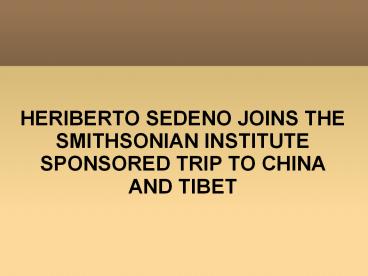HERIBERTO SEDENO JOINS THE SMITHSONIAN INSTITUTE SPONSORED TRIP TO CHINA AND TIBET - PowerPoint PPT Presentation
Title:
HERIBERTO SEDENO JOINS THE SMITHSONIAN INSTITUTE SPONSORED TRIP TO CHINA AND TIBET
Description:
Heriberto Sedeno visited China and Tibet in May 16, 2012. This trip was led by Virginia Bower, a Princeton graduate and adjunct Associate professor at the University of the Arts in Philadelphia. – PowerPoint PPT presentation
Number of Views:73
Title: HERIBERTO SEDENO JOINS THE SMITHSONIAN INSTITUTE SPONSORED TRIP TO CHINA AND TIBET
1
HERIBERTO SEDENO JOINS THE SMITHSONIAN INSTITUTE
SPONSORED TRIP TO CHINA AND TIBET
2
Heriberto Sedeno visited China and Tibet in May
16, 2012. This trip was led by Virginia Bower, a
Princeton graduate and adjunct Associate
professor at the University of the Arts in
Philadelphia. She has contributed to numerous
museum catalogs and exhibitions, a co-editor of
Chinese Ceramics from the Paleolithic period to
the Qin dynasty. Ms. Bower as an expert in
Chinese art and archeology contracted with
Smithsonian Institute to lead this cultural
voyage to China and Tibet.
3
Mr. Sedeno left Austin to join other members of
the group in San Francisco to take the 12-hour
flight to Beijing. His exploration of Beijing,
a 2,000-year-old city, began at Tiananmen Square
the symbolic heart of China visiting the
Forbidden City, seat of imperial power during the
Ming and Qin dynasty. He also visited the Temple
of Heaven where the emperors once worshipped and
the Great Wall of China (a UNESCO World Heritage
Site) at the Mutianyu section of the wall, where
he took a cable car up to the partially
reconstructed ramparts and walk along the
seemingly endless fortification over 4,000 miles
in length.
4
Mr. Sedeno also rode a rickshaw ride along the
Beijing Hutongs (the old imperial neighborhoods
by the side of the Forbidden City). There he
visited a traditionalist, communal life-style
home of a calligraphist and his family. Next
stop, the Summer Palace, the previous home of the
Empress Dowager Cixi in late 19th early 20th
century, whose final act of power was to install
Puyi, at the age of three, as the last emperor of
China. This historic event was depicted in the
1987 biopic The Last Emperor of China. Puyis
life is shown from his ascent to the throne in
1908 as a small boy, overseen the collapse of his
Manchurian Qin dynasty in 1920, to his
imprisonment and political rehabilitation by the
Chinese communist regime.
5
From Beijing, the travel group flew to Xian the
Imperial capital city of many dynasties. Xian
is located in the Shaanxi province along the Wei
river valley. It is also significant in history
that this city was the beginning of the Silk
Road a 4,000 mile trail ending in Damascus,
Syria close to the Mediterranean thus connecting
with Europe. At Xian Mr. Sedeno visited the
world famous site of the Terra-cotta Warriors.
7,000 life-size soldiers created to guard Chinas
first emperor (Qin Shihuang 210 BCE) in the
afterlife. He also took a leisurely walk on top
of the famous imperial walls, which fortified the
city.
6
Next stop, Chengdu, where Mr. Sedeno visited the
renowned Giant Panda Protection and Research
Center, the only such panda refuge in the world.
Chengdu is the provincial capital of Sichuan,
famous for its agricultural productivity and fine
spicy cuisine. Paper money was first circulated
here in the 11th century, and financial
institutions remain a pillar of the citys
economy. Textiles also add to Chengdus historic
reputation for weaving fine silk brocades which
were traded on the Silk Road to be enjoyed by
European royalty. Of important note, during
World War II, Chengdu became a base for US B-29s
that flew from India over the Himalayan called
the Hump to China.
7
Chengdu is the entry point to Lhasa, Tibet, which
will be discussed in another article.































